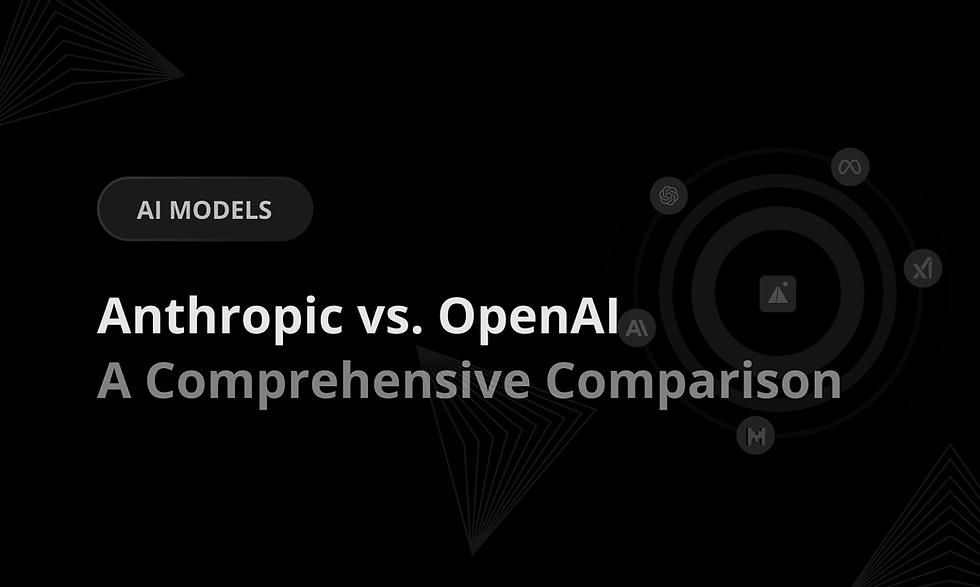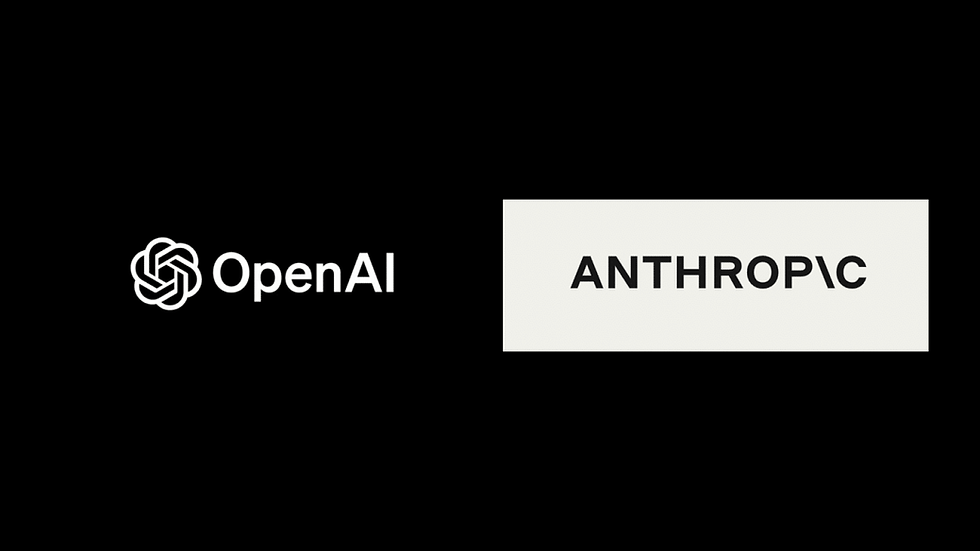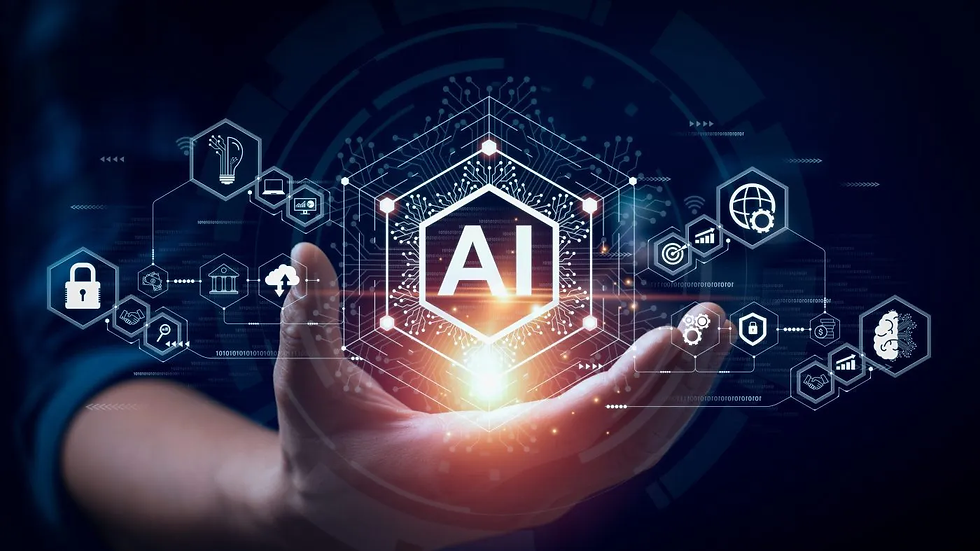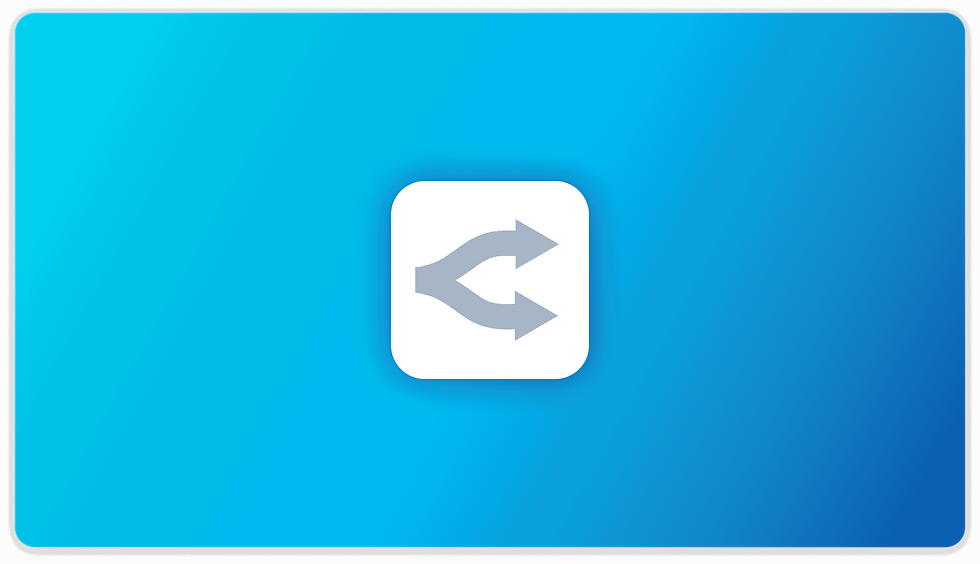OpenAI vs Anthropic: The Battle Shaping the Future of AI Innovation in 2025
- Ethan Carter

- Aug 7
- 11 min read

Artificial Intelligence (AI) stands at the forefront of technological revolution, reshaping industries, economies, and daily life. Among the myriad players driving this transformation, OpenAI and Anthropic have emerged as two powerful forces in AI innovation. As 2025 unfolds, their rivalry is not merely a contest of capabilities but a defining narrative of the ethical, technical, and market-driven evolution of AI.
In this comprehensive analysis, we dive deep into the ongoing battle between OpenAI and Anthropic — exploring their origins, technological breakthroughs, strategic visions, ethical frameworks, and market implications. Whether you're a developer, investor, policymaker, or AI enthusiast, understanding this dynamic is crucial for grasping the trajectory of AI innovation in the near future.
The Rise of OpenAI and Anthropic: Origins and Missions

OpenAI was founded in 2015 with a mission to ensure that artificial general intelligence (AGI) benefits all of humanity. It started as a nonprofit research lab aiming to democratize AI advancements while prioritizing safety and transparency. Over time, OpenAI evolved into a capped-profit company, balancing innovation with commercial viability.
Anthropic, by contrast, was established in 2021 by former OpenAI researchers including Dario Amodei. Its foundation was grounded in addressing AI alignment and safety challenges through principled research and a commitment to long-term ethical development. Anthropic positions itself as a safety-first AI company focusing on interpretable and steerable models to reduce risks associated with powerful AI systems.
Both organizations share a vision of transformative AI but diverge slightly in their approaches—OpenAI emphasizes rapid innovation coupled with safety measures, whereas Anthropic prioritizes rigorous safety research before scaling.
Key Milestones
Year | OpenAI | Anthropic |
|---|---|---|
2015 | Founded; GPT series development | N/A |
2018 | GPT released | N/A |
2020 | GPT-3 launched | N/A |
2021 | Transitioned to capped-profit | Founded by ex-OpenAI staff |
2023 | GPT-4 launch | Claude AI debut |
2024 | New API offerings; multimodal advances | Released Claude+ with enhanced safety features |
Understanding their foundational philosophies helps clarify why their products, partnerships, and market strategies differ significantly today.
Beyond their founding stories, both companies’ missions have influenced their organizational cultures and investment priorities. OpenAI’s early openness in sharing research fostered a community-driven approach, which later shifted toward commercial partnerships to fund expensive model training. Anthropic, built from a core team of safety researchers, channels substantial resources into interpretability research, reflecting its foundational commitment to preemptively addressing AI risks.
Technological Innovations: Comparing AI Architectures and Models

At the core of the OpenAI vs Anthropic rivalry lies their respective AI model architectures and innovation pipelines. Both companies leverage transformer-based large language models (LLMs), yet their design philosophies, training regimes, and safety mechanisms vary.
OpenAI’s Technological Edge
OpenAI’s GPT series has set industry standards for natural language understanding and generation. The release of GPT-4 marked a leap forward with:
Multimodal input capabilities (text + images), enabling richer contextual understanding and interaction modes. For example, GPT-4 can analyze images to answer questions, generate captions, or assist in visual creativity tasks, expanding AI utility beyond text.
Enhanced contextual understanding spanning thousands of tokens, allowing GPT-4 to maintain coherent conversations, synthesize long documents, and perform complex reasoning over extended inputs. This capability supports applications such as legal document review or multi-turn dialogue systems.
Fine-tuned versions adapted for coding (Codex), reasoning, and creativity, enabling specialized applications like code generation, debugging aids, and creative writing assistance. Codex powers GitHub Copilot, which has become indispensable for many developers, accelerating software development workflows.
Moreover, OpenAI integrates reinforcement learning from human feedback (RLHF) extensively to improve model alignment with user intent, reducing undesired outputs and enhancing response relevance. RLHF allows iterative refinement based on real-world user interactions, which helps models adapt to nuanced expectations and social norms.
OpenAI’s continuous improvements also encompass system-level optimizations such as better latency, API stability, and scalability, enabling enterprises to deploy GPT-powered solutions reliably at scale.
Anthropic’s Safety-Centric Architecture
Anthropic focuses on constitutional AI, an innovative training technique that uses an internal set of ethical principles (“constitution”) to guide model behavior without direct human intervention for every decision. This method trains the model to critique and revise its outputs based on predefined guidelines, reducing the need for manual labeling and human moderation.
Key features include:
Models like Claude designed for more predictable and controllable responses, especially in sensitive contexts where minimizing harmful or biased outputs is paramount. Claude models often demonstrate more conservative behavior, avoiding controversial or unsafe content.
Emphasis on transparency via interpretability research, developing tools that allow researchers and users to peek inside model decision-making processes. This fosters trust and facilitates debugging of unexpected or erroneous behaviors.
Closed-loop feedback systems that combine automated constitutional AI training with selective human oversight to iteratively improve safety without sacrificing scalability.
Anthropic’s approach reduces reliance on large-scale human labeling, potentially scaling safer models faster while maintaining a principled framework to enforce ethical boundaries. This methodology has made Anthropic a leader in the emerging field of AI governance and alignment research.
Technical Comparison Table
Feature | OpenAI (GPT-4) | Anthropic (Claude+) |
|---|---|---|
Model Size | ~175B parameters | Estimated ~100B+ parameters |
Training Data | Diverse internet corpora + curated data | Similar data + safety-focused corpora |
Multimodal Capabilities | Yes (text & images) | Primarily text-focused |
Safety Techniques | Constitutional AI + interpretability | |
API Accessibility | Extensive via Azure & OpenAI APIs | Available via cloud partnerships |
Fine-tuning Flexibility | High | Moderate |
Both models continue evolving rapidly, with OpenAI often leading in raw performance metrics, while Anthropic pushes boundaries on ethical robustness.
In practice, OpenAI’s models are often favored for applications requiring versatility and integration with multimodal data, such as creative content generation or complex analysis tasks. Anthropic’s models are preferred in environments where explainability, risk mitigation, and regulatory compliance are non-negotiable, such as finance or government use cases.
For deeper technical dives into LLM architectures, visit DeepMind’s research page.
Ethical AI: How OpenAI and Anthropic Address Safety and Responsibility

The battle between OpenAI and Anthropic is as much about ethics as it is about technology. As LLMs become more central to decision-making across sectors, responsible AI development is paramount.
OpenAI’s Ethical Commitments
OpenAI’s approach to ethical AI includes:
Transparent research publications that share insights on model capabilities and limitations, fostering community awareness and enabling external audits.
Partnerships with governments and NGOs to shape policy, ensuring AI technologies are developed in alignment with societal values and legal frameworks. OpenAI’s engagement with policymakers helps anticipate regulatory shifts and promotes responsible AI deployment.
A commitment to broadly distributed benefits from AGI, focusing on preventing concentration of power and ensuring equitable access to AI advancements.
Implementation of content filters and usage policies to curb misuse, including real-time moderation tools that detect harmful language, misinformation, or disallowed content in user interactions.
OpenAI also actively works on mitigating biases in model outputs through iterative fine-tuning and dataset curation. For example, they have incorporated demographic fairness measures and expanded feedback loops to detect and reduce stereotypical or prejudiced responses.
These efforts extend to external collaborations with researchers and civil society groups to address emerging ethical dilemmas, such as AI-generated misinformation or deepfake detection.
Anthropic’s Safety-First Framework
Anthropic places safety at the center through:
Research into model alignment, developing methods that ensure AI outputs reliably match human values, even in ambiguous or complex scenarios. This includes testing models against adversarial prompts and edge cases.
Developing interpretability tools that allow humans to understand model reasoning, such as visualization of attention patterns or decision pathways, enabling users to identify potential biases or errors.
Applying constitutional AI to enforce ethical boundaries without heavy supervision, allowing models to self-regulate based on an internal ethical framework. This reduces human workload and increases consistency in safety enforcement.
Collaboration with policymakers to establish robust AI governance frameworks that anticipate risks and promote transparency, helping governments craft regulations grounded in technical realities.
Anthropic often publishes detailed whitepapers on risk mitigation strategies, emphasizing transparency and open dialogue with the AI research community. Their work on AI risk assessment explores long-term concerns related to superintelligent systems and societal impact.
Ethical Challenges Both Face
Despite best efforts:
Biases embedded in training data remain challenging to eradicate. Models trained on vast internet data inherit societal prejudices and misinformation, requiring ongoing mitigation efforts.
Balancing openness with misuse prevention is an ongoing tension. Providing broad access to powerful AI can democratize innovation but also risks enabling harmful applications, such as disinformation campaigns or automated harassment.
Defining universal ethical standards across cultures complicates alignment. What is considered acceptable or harmful varies globally, requiring adaptable frameworks that respect diverse values.
Both companies are investing in multistakeholder engagement, including ethicists, sociologists, and affected communities, to surface nuanced perspectives and improve AI governance.
Market Strategies and Partnerships: Who’s Winning the AI Ecosystem?

The competition extends beyond tech — OpenAI and Anthropic are vying for dominance in partnerships, customer acquisition, and ecosystem integration.
OpenAI’s Market Penetration
OpenAI benefits from:
Microsoft’s $10B+ investment, integrating its models into Azure cloud services, which provides scalable infrastructure and enterprise-grade security, facilitating adoption by Fortune 500 companies.
Embedding GPT capabilities in Microsoft Office products (Word, Excel), enabling millions of users to access AI-powered writing assistance, data analysis, and automation directly within familiar productivity tools.
Broad API adoption by startups and enterprises globally, supported by extensive documentation, SDKs, and developer communities that foster rapid innovation.
Developer-friendly tools like ChatGPT plugins expanding use cases into booking systems, real-time data querying, and third-party service integration, driving ecosystem growth.
OpenAI’s public presence is robust, with high brand recognition among consumers and businesses alike, helped by product launches that target both technical and non-technical audiences.
Anthropic’s Strategic Alliances
Anthropic has taken a more cautious but focused route:
Secured partnerships with Google Cloud for infrastructure support, leveraging Google’s global data centers and AI tools to ensure reliable and scalable deployments.
Targeted enterprise customers prioritizing security-sensitive applications, such as financial institutions and government agencies, where compliance and explainability are critical.
Emphasized API contracts with government agencies interested in trustworthy AI to support policy analysis, intelligence summarization, and secure communication tools.
Invested heavily in niche markets such as finance and healthcare where safety is critical, offering customized solutions that meet stringent regulatory requirements and facilitate auditability.
Anthropic’s reputation as a leader in ethical AI attracts clients wary of regulatory scrutiny, positioning it as a trusted partner for risk-averse organizations.
Market Share Snapshot (2025 Estimates)
Company | Estimated Revenue (2025) | Key Markets | Developer Ecosystem Strength |
|---|---|---|---|
OpenAI | Global SMBs, enterprises | Very strong | |
Anthropic | $500M - $1B | Regulated industries (govt., finance) | Growing |
OpenAI dominates mainstream adoption; Anthropic leads specialized sectors demanding higher trust.
Both companies are actively expanding their ecosystems by sponsoring hackathons, developer grants, and research collaborations, fueling innovation pipelines and maintaining competitive edges.
Use Cases and Industry Impact: Real-World Applications in 2025

Both companies power transformative applications across industries — their strengths reflect underlying priorities.
OpenAI-Powered Innovations
Customer Service: ChatGPT-like assistants handle millions of inquiries daily, automating support across e-commerce, telecommunications, and travel sectors. These bots can understand complex queries, perform transactions, and escalate issues seamlessly, reducing operational costs and improving customer experience.
Content Creation: Automated writing tools generate marketing content, code snippets, legal drafts, and creative stories. For example, media companies use GPT-4 to draft articles and social media posts rapidly, freeing human writers to focus on strategy and editing.
Education: Personalized tutoring platforms adapt lessons using GPT models, offering tailored explanations, practice problems, and feedback. Schools and edtech startups deploy GPT-powered chatbots to support diverse learning styles and languages.
Healthcare: Diagnostic support tools assist clinicians with literature review synthesis, symptom checking, and treatment recommendation summaries. While not replacing doctors, these tools accelerate patient care by providing evidence-based insights in real-time.
Example: A leading e-commerce giant uses GPT-based chatbots reducing customer wait times by 40%, enhancing satisfaction and increasing conversion rates through personalized recommendations.
Anthropic’s Impactful Deployments
Finance: Risk assessment models that explain decisions transparently, aiding compliance officers in understanding credit scoring, fraud detection, and investment risk evaluation. This transparency supports regulatory audits and builds stakeholder trust.
Government: Secure information summarization respecting privacy, enabling agencies to process classified data without compromising confidentiality. Anthropic’s models help draft policy briefs and analyze legislation efficiently.
Legal: Contract analysis ensuring compliance with regulatory frameworks, highlighting risky clauses, obligations, and inconsistencies. Law firms and corporate legal departments use Claude+ to streamline due diligence and contract review workflows.
Safety-Critical Systems: Early warning systems where error tolerance is minimal, such as infrastructure monitoring or emergency response coordination. Anthropic’s models provide explainable alerts that operators can trust and act upon promptly.
Example: A multinational bank integrates Claude+ for fraud detection workflows requiring explainable AI outputs to satisfy auditors, reducing false positives by 25% and accelerating investigations.
Cross-Sector Synergies
The combined presence of both companies accelerates innovation by:
Providing options balancing raw capability with safety demands, allowing clients to choose models aligned with their risk profiles.
Encouraging ecosystem competition leading to faster iteration, which benefits end-users through improved features and reliability.
Informing policy frameworks through demonstrated best practices, as both companies engage actively with regulators and standards bodies.
This dynamic fosters a healthy AI ecosystem where innovation and responsibility coexist, driving adoption across sectors from manufacturing to creative arts.
For case studies on AI applications see MIT’s Technology Review.
Challenges Ahead: Regulatory, Technical, and Competitive Hurdles

Despite impressive progress, OpenAI and Anthropic face significant challenges shaping their trajectories.
Regulatory Landscape
Governments worldwide are drafting regulations targeting:
Data privacy compliance (e.g., GDPR, CCPA), requiring companies to ensure user data used in training and inference respects consent and protection laws.
Algorithmic transparency requirements demanding explainability of AI decisions, especially in high-stakes domains like healthcare, finance, and criminal justice.
Limits on deployment in sensitive domains such as autonomous weapons, surveillance, or critical infrastructure, imposing strict controls or outright bans.
Adapting quickly to changing laws without stifling innovation remains difficult. Both companies invest in legal teams and compliance frameworks to anticipate and influence policy development while maintaining agility.
Technical Barriers
Scaling models further demands enormous computational resources, leading to high costs and environmental concerns. Innovations in energy-efficient training, model pruning, and hardware acceleration are critical.
Ensuring robustness against adversarial attacks is critical to prevent exploitation or manipulation of AI systems, which could cause erroneous outputs or security breaches.
Reducing hallucinations (factually incorrect outputs) continues as a core research challenge. Despite improvements, LLMs occasionally generate plausible-sounding but false information, limiting trust in critical applications.
Ongoing research in model interpretability, uncertainty quantification, and grounding AI in verified data sources aims to address these issues.
Competitive Pressure
New entrants backed by tech giants like Google DeepMind or Meta are ramping up competition. Smaller startups focusing on niche applications also nibble away market share with specialized innovations or lower-cost alternatives.
Success depends not just on model quality but navigating complex ecosystems involving users, regulators, and partners. Companies must balance speed, safety, and scalability to maintain leadership.
Both OpenAI and Anthropic are accelerating partnerships, open innovation programs, and talent acquisition to sustain momentum.
Looking Forward: What the Future Holds for AI Innovation
The OpenAI vs Anthropic battle is emblematic of broader tensions in AI development between rapid innovation and cautious safety-first design. Looking ahead:
We expect greater collaboration between these players around standards for responsible AI, possibly through joint initiatives or industry consortia to harmonize safety protocols and interoperability.
Advances in multimodal learning will blur lines between text, image, video, and audio understanding, enabling richer, more intuitive human-AI interactions across devices and contexts.
Regulatory clarity will push companies toward more transparent model governance, including audit trails, explainability standards, and compliance certifications.
Democratization of powerful AI tools will empower new industries such as personalized medicine, climate modeling, and creative arts while raising new ethical questions about privacy, job displacement, and misinformation.
Research into AI alignment and interpretability will deepen, potentially unlocking safer pathways toward AGI by ensuring systems remain controllable and aligned with human intentions.
Ultimately, this competition accelerates progress while ensuring that AI remains aligned with human values — a balance critical for realizing its full potential.
Explore future trends in our article on .
FAQ: OpenAI vs Anthropic in 2025
Q1: What differentiates OpenAI’s GPT models from Anthropic’s Claude? A1: While both are advanced large language models, OpenAI focuses on broad capability with multimodal inputs and extensive fine-tuning via RLHF. Anthropic emphasizes safety through constitutional AI methods prioritizing interpretability and alignment, making Claude more predictable in sensitive applications.
Q2: Which company leads in commercial adoption? A2: OpenAI currently leads mainstream adoption due to strong partnerships like Microsoft Azure integration and widespread API usage. Anthropic targets specialized sectors valuing higher safety assurances, such as government and regulated industries.
Q3: How do both companies handle AI ethics? A3: OpenAI employs human-in-the-loop moderation combined with policy development and external collaborations. Anthropic develops principled internal frameworks guiding behavior via constitutional AI for safer outputs and advances interpretability research.
Q4: Are there risks associated with these new AI systems? A4: Yes. Risks include biases embedded within training data, misuse potential, misinformation propagation, and challenges in ensuring full alignment with human values despite safeguards. Both companies actively research mitigation strategies.
Q5: How can developers access these technologies? A5: Both offer APIs—OpenAI has a wider developer ecosystem through Azure and standalone APIs; Anthropic provides APIs targeted at enterprises focusing on sensitive use cases, often with additional safety layers and compliance support.
Conclusion
The rivalry between OpenAI and Anthropic is much more than a corporate competition — it embodies the evolving philosophy of artificial intelligence itself. In 2025, these two leaders are pushing the boundaries of what machines can understand and create while wrestling with profound ethical responsibilities. Their technological innovations shape diverse industries from healthcare to finance; their approaches influence global policy debates on safe AI deployment.
For anyone invested in the future of technology, keeping a close eye on this battle offers valuable insights into how artificial intelligence will integrate with society — striking a balance between innovation speed and ethical prudence that ultimately defines long-term success.


